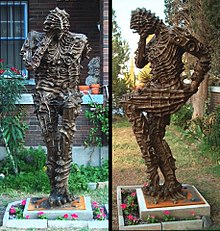Luis Alfonso JiménezJr. was an American sculptor and graphic artist of Mexican descent who identified as a Chicano. He was known for portraying Mexican, Southwestern, Hispanic-American, and general themes in his public commissions, some of which are site specific. The most famous of these is Blue Mustang. Jiménez died in an industrial accident during its construction. It was commissioned by the Denver International Airport and completed after his death.
The Park Place Gallery was a contemporary cooperative art gallery, in operation from 1963 to 1967, and was located in New York City. The Park Place Gallery was a notable as a post-World War II gallery for both its location and that it supported a group of artists working with geometric abstraction and space.
César Augusto Martínez is an artist, prominent in the field of Chicano art. While studying at what was then called Texas A&I College, he became involved in the Chicano movement for civil rights. He subsequently befriended several of its leaders.

Founded in 1959, The El Paso Museum of Art (EPMA) is located in downtown El Paso, Texas. First accredited in 1972, it is the only accredited art museum within a 250-mile radius and serves approximately 100,000 visitors per year. A new building was completed in 1998. In addition to its permanent collection and special exhibitions, the museum also offers art classes, film series, lectures, concerts, storytelling sessions and other educational programs to the West Texas, Southern New Mexico and Ciudad Juarez, Mexico community.

Thomas "Tom" Calloway Lea III was an American muralist, illustrator, artist, war correspondent, novelist, and historian. The bulk of his art and literary works were about Texas, north-central Mexico, and his World War II experience in the South Pacific and Asia. Two of his most popular novels, The Brave Bulls and The Wonderful Country, are widely considered to be classics of southwestern American literature.
Linda Ridgway is an American artist in Dallas, TX known for sculpting and printmaking works. Her focus is on themes of femininity, tradition, and heritage. Ridgway is known for her bronze wall reliefs.

Frances Bagley is an American sculptor who was born in Fayetteville, Tennessee. Her sculptures are made from many different materials including metal, stone, human hair and fabric. Recently she has also included video into her art. She lives and works in Dallas,Texas.
Leo Sewell is an American "found object" artist. His assemblages of recycled material are in over 40 museums and in private collections worldwide.
Roger White Stoller is an American sculptor who specializes in large works integrating stainless steel, bronze and granite. He currently works out of studios in Portola Valley and San Jose, California.

Jesús Bautista Moroles was an American sculptor, known for his monumental abstract granite works. He lived and worked in Rockport, Texas, where his studio and workshop were based, and where all of his work was prepared and finished before being shipped out for installation. In 2008, he was awarded the National Medal of Arts. Over two thousand works by Moroles are held in public and private collections in the United States, China, Egypt, France, Italy, Japan, and Switzerland.
Steve Brudniak is an American artist, actor, filmmaker and musician. Known for highly crafted, unusual assemblage sculpture, imbued with transcendental and unique scientific elements; his visual art career spans over four decades, with work in the permanent collections of several art museums in United State. His acting and film endeavors began at the age of 13. Some notable roles include pivotal characters in Richard Linklater’s Waking Life and Robert Rodriguez’s Hypnotic. Brudniak was also a founding member of Spiny Normen and other psychedelic music groups from 1977 ‒ present and operated Victorian Recording Studio during the mid 1980’s. He spent his elementary, high school years, and early 20’s in Houston, Texas, eventually moving to Austin, Texas where he currently lives.

Jason Villegas is currently a San Francisco based contemporary artist. He has exhibited across the United States and internationally. Villegas' work utilizes a wide spectrum of mediums including sculpture, installation, painting, drawing, textile, video and performance. He has created his own artistic realm and visual language in which to explore concepts such as globalism, evolution, sexuality, cosmology, and consumerism. Motifs in Villegas' artworks include fashion logos, animal hybrids, weaponry, sales banners, clothing piles, anuses, cosmic debris, taxidermy, bear men, amorphous beasts, religious iconography, and party scenarios.
Tom Nussbaum is an American artist known for a variety of work including sculpture, drawings, paper cuts, prints, children’s books, animations, functional design objects, public art, and site-specific commissions.
Margarita Cabrera is a Mexican-American artist and activist. As an artist, the objects and activities she produces address issues related to border relations, labor practices and immigration. Her practice spans smaller textile-based soft sculptures to large community-involved public artworks. In 2012 she was a recipient of the Knight Artist in Residence at the McColl Center for Visual Art in Charlotte, NC. Cabrera was also a recipient of the Joan Mitchell Foundation Grant.
Tony Feher was an American sculptor. He was born in Albuquerque, New Mexico, and was raised in Corpus Christi, Texas. He received a Bachelor of Arts from the University of Texas at Austin, in 1978. He began exhibiting fine art in 1980 and had his first solo show at Wooster Gardens in 1994, and shortly thereafter was reviewed favorably by Roberta Smith in a short article titled "Three Artists Who Favor Chaos:" "Tony Feher's chaos is actually rather well-organized and instinctively archival and devotional." Since then, notable solo exhibitions of his work have taken place at Diverseworks in Houston; Sikkema Jenkins & Co., Pace Gallery, and D’Amelio Terras in New York; ACME in Los Angeles; Anthony Meier Fine Arts in San Francisco; and The Suburban in Oak Park, Illinois.
Gaspar Enriquez is an American artist known for creating photorealist portraits, primarily of people of Chicano heritage. He uses the airbrush technique in his paintings. Enriquez is also a sculptor and a jewelry maker who works in metal.
Becky Duval Reese is an American curator and art museum director. She is best known for her work as the director of the El Paso Museum of Art (EPMA) and oversaw the museum's move in 1998. She was inducted into the El Paso Women's Hall of Fame in 2005.
Zeke Peña is an American cartoonist, illustrator, and writer. He has won multiple awards for illustration, including for his work in two books by Isabel Quintero; My Papi Has a Motorcycle and Photographic: The Life of Graciela Iturbide. His work deals with themes of American history, the culture of the border region, folklore, and social justice.
James Magee is an American artist from Fremont, Michigan. As of 2021, he was based in El Paso, Texas, where he has developed most of his artistic career. His main artistic focus has been The Hill of James Magee, an art installation located in the Chihuahuan Desert, one hour and twenty minutes outside of El Paso.




